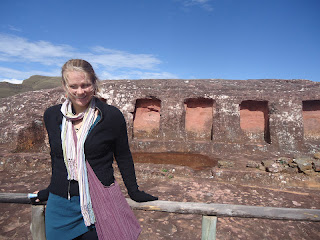 |
| Saimapata's views were great– a nice change of pace from dry, dusty, red Sucre! |
I have a talent for choosing the sketchiest bus companies. I honestly don't know how I do it– but I never end up on a tourist bus. And I don't always necessarily buy the cheapest ticket, I just believe the vendors when they tell me the bus is nice. Stupid, stupid, stupid. Friday night I had a loooong bus ride to Samaipata, like 12 hours long. And the bus was well, it was riding the struggle bus. I am surprised it didn't break down. Twelve hours on a wheezing bus. But I wish it was longer since I arrived in Samaipata at 4:30 in the morning. And when I say I arrived, I mean my bus, which was actually a bus to Santa Cruz stopped on the side of the road, let me, and only me, off, and then took off again, leaving me stranded on the side of a Bolivian road (supposedly a highway– but don't picture an eight lane road. It was a highway because it was paved) at 4:30 in the morning. Luckily, there were streetlights and I saw two people with rolling suitcases about a block away. So, I took my chances and followed them instead of waiting under a streetlight until the sun came up. It was a good move on my part as they were two tourists looking for a hostel. One of them had been to Samaipata before so he knew where the main square was. From there, I was able to find my hostel that I had booked ahead of time because I was scared I would get to Samaipata early- as in 6. NOT 4:30. I am lucky that everything went smoothly upon my arrival in Samaipata– that could have been the start to a very bad situation.
Later that morning, I had another stroke of luck by basically being adopted by a Bolivian family and accompanying them to El Fuerte– a pre-Inca ruin. Contrary to what one may think because the
 |
| El Fuerte |
 |
| El Fuerte |
 friendly and gregarious. At the conclusion of our El Fuerte walk one of the woman bought me a necklace– so now I will always have a reminder of that wonderful morning at El Fuerte. Later that day I went to an interesting archaeological museum (no photos allowed). Archaeologists are finding a number of new sites and artifacts at an alarmingly fast pace– Samaipata is just teeming with history! The rest of the day I sat in the sun and read and enjoyed the warm weather, I was 1000 meters lower than Sucre so it was pretty balmy.
friendly and gregarious. At the conclusion of our El Fuerte walk one of the woman bought me a necklace– so now I will always have a reminder of that wonderful morning at El Fuerte. Later that day I went to an interesting archaeological museum (no photos allowed). Archaeologists are finding a number of new sites and artifacts at an alarmingly fast pace– Samaipata is just teeming with history! The rest of the day I sat in the sun and read and enjoyed the warm weather, I was 1000 meters lower than Sucre so it was pretty balmy.
No comments:
Post a Comment